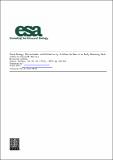Por favor, use este identificador para citar o enlazar a este item:
http://hdl.handle.net/10261/42300COMPARTIR / EXPORTAR:
 SHARE SHARE
 CORE
BASE CORE
BASE
|
|
| Visualizar otros formatos: MARC | Dublin Core | RDF | ORE | MODS | METS | DIDL | DATACITE | |

| Título: | Floral Biology, Microclimate, and Pollination by Ectothermic Bees in an Early-Blooming Herb Read More: http://www.esajournals.org/doi/abs/10.2307/1940644 |
Autor: | Herrera, Carlos M. CSIC ORCID | Fecha de publicación: | ene-1995 | Editor: | Ecological Society of America | Citación: | Ecology, 78(1): 218-228 (1995) | Resumen: | Abiotic factors may constrain the functioning of species interactions such as plant—pollinator mutualisms. I investigated how thermal environment affects the interaction between the early—blooming daffodil, Narcissus longispathus (Amaryllidaceae) and its major bee pollinator (Andrena biclor; Andrenidae), focusing simultaneously on plant and pollinator sides of the interaction. I studied fruit and seed set, flower duration, and the intrafloral thermal environment of N. longispathus, and the thermal biology, foraging behavior, and thermoregulatory ability of A. bicolor, over a 6—yr period in southeastern Spain. N. longispathus flowers from February to April, when unsuitable weather often limits pollinator activity, yet most flowers are successfully pollinated in all years and sites. Fruit set was weakly pollen limited, but among flowers setting fruit the proportion of ovules developing into seeds was not. Individual flowers lasted for 17 d on average, remaining functional during the period. On sunny days, the air inside N. longispathus flowers was significantly warmer than outside. Mean temperature excess inside flowers was as high as 8°C, and was positively related to solar irradiance. Within flowers, air temperature was highest around the anthers; this intrafloral gradient was consistent with variation among perianth parts in radiation transmittance. Andrena bicolor foraged in N. longispathus flowering patches only on sunny days with air temperature >12°—13°C, and foraging behavior and flower visitation rate when temperature dependent. Bees were able to fly at relatively low thoracic temperatures (Tth; range 22°—31°C) and this was essential for successfully foraging at N. longispathus. Under the range of irradiance and air temperature found at foraging sites, A. bicolor individuals inside flowers were able to reach Tth suitable for flight by passive means alone. Under laboratory conditions, A. bicolor was unable to raise or otherwise regulate Tth by physiological means, but free—flying individuals thermoregulated behaviorally. Basking was used to raise Tth, and intrafloral microclimate, by influencing the proportion of foraging time devoted to basking, played an important role in thermoregulaton. Flower visitation rate was positively related to the average temperature inside visited flowers, and the probability of basking immediately after one floral visit declined with increasing flower temperature. I conclude that the favorable microclimate within N. longispathus flowers, their long duration, and the thermal biology of A. bicolor, were critical elements in this early—season pollination system. | Versión del editor: | http://www.jstor.org/stable/pdfplus/1940644.pdf | URI: | http://hdl.handle.net/10261/42300 | DOI: | 10.2307/1940644 |
| Aparece en las colecciones: | (EBD) Artículos |
Ficheros en este ítem:
| Fichero | Descripción | Tamaño | Formato | |
|---|---|---|---|---|
| 1940644.pdf | 359,21 kB | Adobe PDF |  Visualizar/Abrir |
CORE Recommender
SCOPUSTM
Citations
137
checked on 22-abr-2024
WEB OF SCIENCETM
Citations
131
checked on 21-feb-2024
Page view(s)
260
checked on 24-abr-2024
Download(s)
1.079
checked on 24-abr-2024
Google ScholarTM
Check
Altmetric
Altmetric
NOTA: Los ítems de Digital.CSIC están protegidos por copyright, con todos los derechos reservados, a menos que se indique lo contrario.
